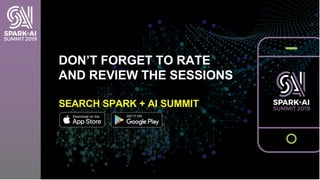Lessons Learned Replatforming A Large Machine Learning Application To Apache Spark
- 1. WIFI SSID:Spark+AISummit | Password: UnifiedDataAnalytics
- 2. Patrick Caldon – Director of Quant Research Taylor Hess – Lead Quant Analyst Morningstar Inc. Lessons Learned Replatforming A Large ML Application #UnifiedDataAnalytics #SparkAISummit
- 3. Roadmap • Our Model • Lessons Learned 1. Just Get A Bigger Cluster 2. End to End Models 3. Make It Easy To Iterate 4. Focus On Local Runs 3
- 4. Our Model 4
- 5. Why Finance Models Are Different 1. Hard to Validate 2. Probabilistic Outputs 3. More collaborative 4. Heavy compliance issues – models and data need versioning 5
- 6. Large ML models even more difficult… • Software installations can be difficult • Data can’t fit on computer • Desktop/Laptop not powerful enough 6
- 7. What Are We Building? • Financial Terms: Risk Factor Model • ML Terms: Cross sectional regression + more 7 Daily Factors Apple Inc. | 2019-01-01 Momentum = 0.3 Size = 2.1 Health = 1.5 • Time series of each coefficient • Forecasted return distributions • Covariance estimates All Stock Data
- 8. What Are We Building? • Essentially, we take features of financial securities and estimate distributions of future returns • We make millions of these estimates • Try to understand how stock returns move together • The feature engineering work has been studied extensively in academic financial research (it is utilized by Quant hedge funds to invest as well) – Some features are simple, some are complex 8
- 9. What Are We Building? 9 • Outputs (~500GB each run) • Security and portfolio exposures (daily for each security/portfolio) • Security and portfolio forecasted distributions (daily for each security/portfolio) • Inputs (~500GB) • Return data • Financial information • Security information (region, sector, etc.) • Portfolio information Security Date Size Momentum … Apple 10/1/2018 2.1 0.4 … Google 10/1/2018 2.0 0.3 … Barclays 10/1/2018 1.6 -0.1 … BP 10/1/2018 1.8 0.7 …
- 10. Risk Model 1.0 10 Years of research and development to come up with our proprietary model • Equity only model (~40,000 securities) • Single server relying on database for many calculations • 10 hours to run each day • Producing ~10M datapoints daily Data Warehouse On Prem Server
- 11. Rethinking Our Approach 11 Hard to expand code Validation is arduous New model creation painful Long time to regenerate
- 12. New Architecture 12 Morningstar API Amazon S3 Amazon RDS Amazon S3 Amazon Route 53 Amazon AthenaAmazon EMR (Spark) Amazon Fargate Airflow
- 13. Risk Model 2.0 13 Old Model g 10 million datapoints each model run g 40,000 securities (equity only) g 1 model at a time g Months to refresh all data g Hard to get validation data New Model g 25 billion datapoints each model run g 1,000,000 securities (equity + fixed income) g 10+ models at a time g Hours to refresh all data g Validation data automated 4000x faster (full rebuild) 5,000x output data (each model run) 50x parallel models
- 14. Four Lessons 14
- 15. 1. Just Get A Bigger Cluster 15
- 16. What is it? • Get larger servers and more of them – then trim down later 16
- 17. Why? It’s easy to do And we should do the easy things first 1. 2x larger >> 2x faster in many cases (so its cost effective) 2. Good joins can’t make up for poorly sized cluster (sometimes) 17
- 18. Some reasons to scale 18 I/O Caching Parallelization
- 19. I/O • Too small of cluster will cause a spill to disk • Writing and reading from disk are slooooooow • Monitor Spark GUI for spills to disk and add more RAM 19
- 20. Caching • If you use large datasets 2+ times, cache • Caching requires lots of RAM • Partial caching not good enough 20
- 21. Parallelization • If data skew is not a problem: 2x larger = 2x faster • Make sure cluster fully utilized – Executor Count / Size 21
- 22. 2. Build Models End To End 22
- 23. What is it? • Ability to rerun models historically • Always keep source data intact 23
- 24. Why? 24 • Distribution of data can shift over time – was your model stable? • Necessary in projects with a time component • Bugfixes quicker • Makes it easy to tweak preprocessing steps
- 25. Model Deployment • Liebig's law of the minimum (~1850) – plant growth is governed by the least available nutrient. (cf. Amdahl's law). • In any software-based environment, end-to-end system test is a necessity. The test will likely find bugs. So the slowest process in our development governs release and bugfix speed. • Liebig's law of the minimum (rephrased) – model development speed is governed by the slowest part of the development/deployment environment. • Conclusion – if you have a multi-day process to rebuild a model, you’re at risk of this process governing the release and bugfix cadence. 25
- 26. 26 Time Raw Storage Prepared Data Model Output Raw Storage Prepared Data Model Output Raw Storage Prepared Data Model Output Raw Storage Prepared Data Model Output Latest Model
- 27. 27 Time Raw Storage Prepared Data Model Output Raw Storage Prepared Data Model Output Raw Storage Prepared Data Model Output Raw Storage Prepared Data Model Output Full Latest Model
- 28. 28 Time Raw Storage Prepared Data Model Output Raw Storage Prepared Data Model Output Raw Storage Prepared Data Model Output Raw Storage Prepared Data Model Output End To End Model
- 29. 3. Make It Easy To Iterate 29
- 30. What is it? • Our team consists of many analysts and a few developers • Big focus on making it easy for analysts to contribute quickly – Easy for analysts to setup – Easy to test – Easy to deploy full runs – Easy to run locally • It’s a simple idea that should be taken seriously 30
- 31. Why? • The magic of compounding! • Lower switching costs to onboard people to project • Less experienced team members can contribute 31
- 32. 32 Sprints 0 1 2 3 4 Lead Developer 20 20 20 20 20 Developer 10 10 10 10 10 Developer 10 10 10 10 10 Developer 10 10 10 10 10 Developer 10 10 10 10 10 Total Work 60 60 60 60 60 Cumulative Work 60 120 180 240 300 Sprints 0 1 2 3 4 Lead Developer 5 8 11 15 18 Developer 10 12 14 16 18 Developer 10 12 14 16 18 Developer 10 12 14 16 18 Developer 10 12 14 16 18 Total Work 45 56 67 79 90 Cumulative Work 45 101 168 247 337 0 50 100 150 200 250 300 350 400 1 2 3 4 5 Total Cumulative WorkIndividual Focus Tooling Focus
- 34. Some things we did – Deployment Scripts to AWS – Clear Documentation – Containers / VM’s – Allow everything to run locally – Data exploration tools (Jupyter, Athena) – Pair analysts and developers 34
- 35. 4. Focus On Local Runs 35
- 36. • Make it easy to run the full process locally • That means you may need: 1. Representative data samples 2. No / minor reliance on external data sources • Api calls, long database queries, etc. 3. Process to snapshot data 36 What is it?
- 37. Why? • Development is much cheaper / quicker 37
- 38. Representative data samples • Not easy to do – We use process that runs on large cluster to create smaller datasets and upload to Cloud – This process sits within code that abstracts data connections • Any external data sources need to be mocked / set in config file to pull from other source 38
- 39. 39 Full Abstracted Data ML Application Full Raw Data Trimmed Raw Data Trimmed Abstracted Data 1. Snapshot to Raw Data
- 40. Conclusion 40
- 41. Its about speed of iteration! • What barriers can you remove? • What process can you improve? • What tools can you create? • What flexibility can you add? • What headache can you avoid? • How can you make it easy to do the right thing? • How can you accelerate the work of inexperienced analysts/devs? 41
- 42. Contact Us • Patrick Caldon – [email protected] • Taylor Hess – [email protected] – https://www.linkedin.com/in/taylorwhess/ 42
- 43. DON’T FORGET TO RATE AND REVIEW THE SESSIONS SEARCH SPARK + AI SUMMIT











































